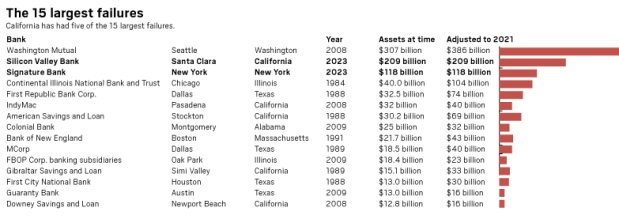Major fails
The second and third-largest bank failures in U.S. history were last week. Here’s a look at the historical significance.
Total bank and thrift failures since 1976
As of March 12:
Thrifts also refer to credit unions and mutual savings banks that provide a variety of savings and loan services. Thrifts differ from commercial banks in that they can borrow money from the Federal Home Loan Bank System, which allows them to pay members higher interest.
Days between failures
The failure of Silicon Valley Bank ended the second-longest streak of days between failures at 870 days. The longest streak was 952 days (2 1/2 years) that ended in 2007 when the Great Recession began.
Bankingstratigist.com has a historical recap of U.S. bank failures.
The 15 largest failures
California has had five of the 15 largest failures.

This link takes you to the FDIC frequently asked questions about bank failure.
What the FDIC is doing

Signature Bank: The Federal Deposit Insurance Corp. formed a bridge bank and transferred assets and deposits from SB, with the FDIC managing the bridge bank pending sale or liquidation. In a joint press release (Federal Reserve Bank, FDIC, U.S. Treasury), it was announced that all depositors — even those with balances in excess of FDIC coverage — would be made whole. There would be no cost to taxpayers as FDIC assessment fees to all other banks would cover the multibillion-dollar rescue.

Silicon Valley Bank: The FDIC formed Deposit Insurance National Bank and transferred assets and deposits from SVB with the FDIC managing the bridge bank pending sale or liquidation. According to public reporting, there were a variety of actions that led to a run on the bank: announcement of bond disposition and large loss, pre-announced plans for significant capital raise, callouts on social media for depositors to withdraw immediately. In a joint press release (Federal Reserve Bank, FDIC, U.S. Treasury), it was announced that all depositors — even those with balances in excess of FDIC coverage — would be mad whole. There would be no cost to taxpayers as FDIC assessment fees to all other banks would cover the multibillion-dollar rescue.
On June 16, 1933, President Franklin Roosevelt signed the Banking Act of 1933, a part of which established the FDIC.

At Roosevelt’s immediate right and left were Sen. Carter Glass of Virginia and Rep. Henry Steagall of Alabama, the two most prominent figures in the bill’s development.
FDIC at a glance
An independent agency of the federal government, the FDIC was created in response to the thousands of bank failures that occurred in the 1920s and early 1930s.
The FDIC receives no congressional appropriations — it is funded by premiums that banks and savings associations pay for deposit insurance coverage. The FDIC insures trillions of dollars of deposits in U.S. banks and thrifts — deposits in virtually every bank and savings association in the country.
Deposit Insurance
The standard insurance amount is $250,000 per depositor, per insured bank, for each account ownership category. Since the start of FDIC insurance on Jan. 1, 1934, no depositor has lost a penny of insured funds as a result of a failure.
The FDIC directly supervises and examines more than 5,000 banks and savings associations for operational safety and soundness.
Sources: FDIC, The Associated Press, BankingStrategist.com
